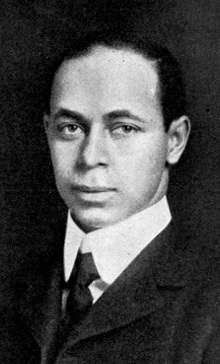Roscoe Conkling Bruce facts for kids
Quick facts for kids
Roscoe Conkling Bruce
|
|
|---|---|
 |
|
| Born | 21 April 1879 Washington, D.C., U.S.
|
| Died | 16 August 1950 (aged 71) New York City, New York, U.S.
|
| Nationality | American |
| Occupation | Educator |
| Known for | Emphasis on industrial training for African Americans |
| Parents |
|
Roscoe Conkling Bruce (born April 21, 1879 – died August 16, 1950) was an African-American educator. He was known for believing that practical skills like industrial and business training were very important. He thought these skills were more useful than just academic subjects. Later in his life, he managed a housing complex called the Dunbar Apartments in Harlem, New York City. He also worked as the main editor for the Harriet Tubman Publishing Company.
Contents
Early Life and School
Roscoe Conkling Bruce was born in Washington, D.C. on April 21, 1879. He was the only son of Blanche Bruce and Josephine Beall Willson Bruce. His father, Blanche Bruce, was a Republican Senator from Mississippi. He was also a former slave. Blanche Bruce was the second African American to be elected to the U.S. Senate. He was also the first to serve a full six-year term.
Roscoe's mother, Josephine Beall Willson, was a teacher. She was hired by Booker T. Washington in 1899 to work at the Tuskegee Institute.
Roscoe was named after Senator Roscoe Conkling of New York. This senator supported Roscoe's father against unfair treatment in the Senate.
His Education Journey
Roscoe went to high school at M Street High School in Washington. Then he attended Phillips Exeter Academy. While there, he helped edit The Exonian, which was the student newspaper.
In 1898, he started at Harvard University. He was very good at debating and public speaking.
- In 1898, he won the Pasteur Medal for debating.
- In 1899, he was chosen to represent Harvard in a debate against Princeton University.
- In 1900, he represented Harvard in a speaking contest against Yale University. He also won the Coolidge debating prize.
He graduated from Harvard in 1902 with a high honor called "magna cum laude." He also became a member of the Phi Beta Kappa Society, which is a very respected academic group.
Roscoe Bruce as an Educator
During a summer break from Harvard, Roscoe visited his mother at Tuskegee. There, he met Booker T. Washington, who was very impressed with him. Washington offered Roscoe a job as the head of the Academic Department at Tuskegee Institute.
From 1902 to 1906, Bruce led the Academic Department at Tuskegee. He also taught classes. Booker T. Washington hired him to change the school's lessons. Washington wanted the school to focus less on traditional academic subjects. Instead, he wanted it to teach more practical skills. This change was not popular with the teachers or the students.
Bruce believed that Tuskegee should become a "first class industrial school." He wanted it to be known for teaching practical skills. He even suggested expanding Tuskegee's ideas to other countries.
Working in Washington D.C. Schools
Bruce wanted to work in the Washington D.C. school system. Booker T. Washington helped him get a job there. Washington did not agree with the ideas of another famous educator, W. E. B. Du Bois. So, Washington worked hard to help Bruce get a good position.
In 1906, Bruce became a supervising principal. He was in charge of a quarter of the black schools in the area. Just a few months later, he was promoted. He became the Assistant Superintendent for the Colored Schools in the District of Columbia.
Bruce strongly believed that industrial and business education were important. He tried to turn the schools into technical high schools. He made sure that every student at Dunbar High School took at least one industrial class. Because of his ideas, new vocational schools were started for both boys and girls.
After leaving his job in Washington D.C., he helped organize high schools for African American children in Kimball, West Virginia. Later, he became the principal of Browns Creek District High School in Kimball.
Later Life and Work
In 1927, Roscoe Bruce moved to Harlem, New York. He became the manager of the Dunbar Apartments. These apartments were built to provide good homes for African Americans who had lower incomes. However, in 1936, Bruce lost his job when the apartments were sold.
In the early 1930s, Bruce became the main editor for the Harriet Tubman Publishing Company. He also wrote a school textbook called Just Women. This book shared the history of important African-American women.
Family Life
On June 3, 1903, Roscoe Bruce married Clara Washington Burrill. She was from Washington, D.C. Clara was a very smart woman. She graduated from Radcliffe and Boston University Law School. She was also the first woman ever to edit a law review. However, because she was a woman and African American, it was hard for her to find work as a lawyer.
Roscoe and Clara had three children: Clara Josephine, Roscoe Conkling Jr., and Burrill Kelso Bruce.
His daughter Clara also went to Radcliffe College, like her mother.
Roscoe Conkling Bruce passed away in New York City on August 16, 1950. He was 71 years old. He was buried in Woodlawn Cemetery in Washington, D.C.

